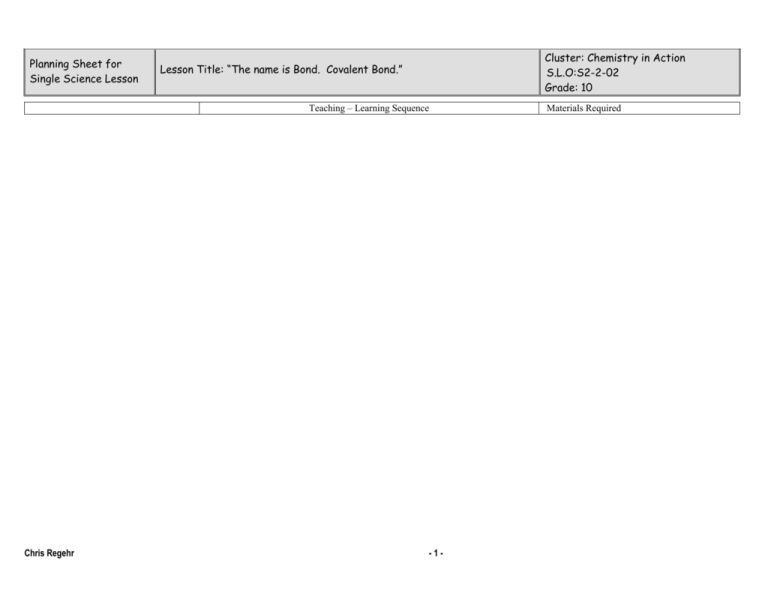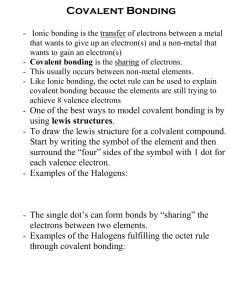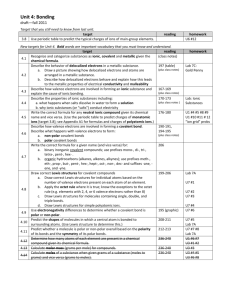Covalent Bonds
advertisement

Planning Sheet for Single Science Lesson Cluster: Chemistry in Action S.L.O:S2-2-02 Grade: 10 Lesson Title: “The name is Bond. Covalent Bond.” Teaching – Learning Sequence Chris Regehr -1- Materials Required A. Cluster 0: Scientific Inquiry Initiating, Researching & Planning S2-0-4e: Work cooperatively with group members to carry out a plan, and troubleshoot problems as they arise S2-0-4f: Assume the responsibilities of various roles within a group and evaluate which roles are most appropriate for given tasks Implementing; Observing, Measuring & Recording S2-0-5c: Record, organize, and display data using an appropriate format. Include: labelled diagrams, graphs, multimedia Analyzing & Interpreting N/A Concluding & Applying S2-0-7e: Reflect on prior knowledge and experiences to develop new understanding B. STSE Issues/ Design Process/ Decision Making N/A Chris Regehr Begin class by repeating demonstration combining Mg and O. Review concept of ionic bonding, concentrating on the valence shell electrons. Follow this by correcting “Lewis Dot Diagrams and Ionic bonding” and answer any questions. Get a feeling of where students are at in terms of their understanding. If they are doing well, move on to covalent bonding. If they are struggling, spend some more time on ionic bonds by reviewing a few more Lewis Dot Diagrams in conjunction with the role-play. Refer to key questions from yesterday: “Why do elements combine to form compounds?”; “How do elements combine?” and “Why do they stay combined?” Tell students that they will learn a second answer to these questions. Perform electrolysis of water (refer to the “Electrolysis of water” handout). Again, perform as discrepant event. Elicit predictions of what they think will happen once you add the electrical leads. Have them observe and then briefly explain. Keep the focus on the production of H2, not on the chemical process of electrolysis. Perform the test indicating presence of H2. Have students role-play situation of the two hydrogen atoms forming. Make sure students realize difference from yesterday’s bonding. In this case, the two elements involved are two NON-METALS. As well, hydrogen has a valence shell with a capacity of two. Both atoms still want their valence shells complete. This answers the first question: atoms combine to complete valence shells. Have students write this down. Refer to ionic bonds and remind students how the metal wanted to get rid of electrons, while the non-metals liked to take electrons. In this case, both atoms want another electron. Ask students what options the atoms have. Refer to Pig Farm Analogy to show the possibility of sharing. The pig farmer is happier if he has a full pen at least some of the time so s/he shares with another farmer. The atoms act similarly. They share electrons. This answers the second key question of how elements combine: two non-metals combine by sharing electrons; by overlapping their valence electron shells, the atoms share pairs of electrons. Have students write this down and the definition of covalent bonding: Covalent bonds result when NON-METAL atoms share electrons. -2- Materials for Electrolysis of Water: 9V battery matches lid or cardboard tongs electrical wire (insulated) with alligator clips two pencils sharpened at both ends small deep bowl (white or glass) two tall narrow jars (try to have them the same size) and one small jar washing soda (sodium carbonate) phenolphthalein indicator “Element labels” String for tying “Element labels” Laptop and projector Internet connection 2 Egg cartons 16 candies for valence electrons Handout “Covalent and Ionic Bonding” Assignment: “Lewis Dot Diagrams” C. Essential Science Knowledge Summary In this lesson, students will be taught that non-metals combine because they want to complete their valence shells. If two nonmetals combine, they do so covalently. A covalent bond is a sharing of a pair of electrons. The shared electrons hold the atoms together. Students will draw Lewis dot diagrams of both covalent and ionic bonds. Noble gases have a full valence shell. They do not form bonds. Diatomic molecules are classified as elements. Will you assess? If so, what? The Lewis dot diagrams will be assessed by the students themselves. They will be given correct answers and determine whether their answers are correct. The analogy/story/poster will be formally assessed How will you assess it? The analogy/story/poster will be assessed on its ability to explain ionic and/or covalent bonding. There will also be a creative element required. Have students role-play this situation, using an egg carton with 2 pockets to indicate the valence shell. To indicate sharing, have the students overlap their “egg carton valence shells” and place the electrons in the combined pockets. Explain how the sharing of electrons is what holds the atoms together. This answers the third key question of why elements stay combined: NON-METAL atoms stay combined because they are sharing electron pairs. Have students write this down. Use animation of covalent bonding found at http://www.visionlearning.com/library/module_viewer.php?mid=55 to reinforce. Also, draw Lewis dot diagram of H2 for the “Before Situation” and “After Situation”. Show how each atom’s valence shell is complete. Follow this, by referring back to the electrolysis demonstration. Show students how another gas was produced. Show test to indicate presence of O2. Have two students perform role-play. In this case, only overlap a pair of the “pockets” in the “egg carton valence shells”. Again, draw Lewis dot diagrams of the situation. Use different symbols for the electrons of the different elements. Explain that diatomic molecules are classified as elements not compounds since they only consist of one element. Refer back to the electrolysis demonstration, and this time take a look at the water itself. Use a role-play to show how the sharing occurs in this situation. Again, draw Lewis dot diagrams. Proceed with a discussion of noble gases and how they would react or if they would react. Ensure that students understand that Noble gases have complete valence shells and therefore, do not form chemical bonds. Have students note this. Use role-play again. Perform whole class role-play again. This time allow for ionic and covalent bonding. Use “Element Labels” but include Silicon and Hydrogen this time. Encourage the creation of covalent bonding. Using the students as atoms, provide example of a covalent bond and an ionic bond to remind students. Use “The name is Bond. But is it Ionic or Covalent?” Handout this time. In order to consolidate lesson, review the concept of covalent bonding and how it differs from ionic bonding. Review the answers to the key questions. Also, review noble gases and diatomic gases. Chris Regehr -3- Questions to consider in your planning / delivery: 1. Does the lesson start through engagement? 2. Am I using this phase as an opportunity to find out where students are ‘at’ in their thinking? 3. Is there an emphasis on first-hand experiences – an evidential phase? 4. Am I helping students to make sense of these experiences – a psychological phase? 5. Is their a theoretical phase where the essential science knowledge is articulated and consolidated? 6. What specific skill and knowledge development am I emphasizing? Is there evidence of clear instructions and purposeful questions in my teaching sequence? Assignment will be “Lewis Dot Diagrams: Ionic and covalent bonding” handout. Students can form groups and complete these tasks together. If time permits assign the following summarizing task: have the groups create their own analogy/story/poster that outlines the basics of ionic and/or covalent bonding. These will be shared in the following class. FINAL NOTE: These lesson plans are to be used at the teacher’s discretion. If students are having difficulty with concepts or need further practice/time, these lessons would be extended over several periods. That is the reality of teaching! Chris Regehr -4-







